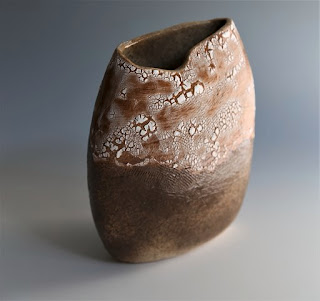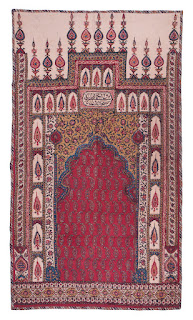 |
| Painting by Vaman Pai |
The ongoing exhibition of paintings by Vaman Pai and ceramics by Gomathi Suresh at Gallery Manora, explore abstract imagery through two diverse visual mediums. The show is curated by Giridhar Khasnis, who writes, “Involved in different mediums, they create works that are not fixed on any particular notion or theme but imagery that is free and open to interpretation. Silent yet evocative, their abstract constructs and formations are coloured with introspective tones and designs.”
Vaman is a Bangalore-based painter and sculptor, who is essentially self-taught. G S Shenoy, the late senior artist known for his abstracted landscapes had a large influence on his artistic vocabulary. Vaman has been painting landscapes for several years and in this series, his works display a natural fluidity and eloquence. There is an evident spontaneity in the rendering and an inclination to capture subtle atmospheric nuances. Inspired by nature, and the colour and vastness of the sky, he has employed a predominantly blue and white palette, experimenting adroitly with gentle patterns and textures.
 |
| Ceramic by Gomathi Suresh |
Gomathi Suresh is a Sydney-based ceramist and art promoter, who has exhibited her works in several group shows and at the Ceramic Art School, Tafe Sydney where she completed her 2-year diploma in ceramic art. She is currently pursuing a 2-year advanced diploma in ceramic art.
In this series, which has been produced in response to Vaman’s paintings, her concern for environment, climate change and ecological sustainability form the underlying subtext. She explains, “My body of work for this exhibition is an immediate and gestural response to the painterly abstraction of Vaman Pai's works whilst maintaining the unique nature of my own making, use of surface treatment and three dimensionalities.” Her works often reference land forms and memories of landscapes from her travels around the world.
 |
| Gallery view of Juxtaposed by Vaman Pai and Gomathi Suresh at Gallery Manora |
Adopting multiple techniques, ranging from the traditional to the more experimental, Gomathi has played with glazes and firing processes to achieve textures, patterns and compelling visual effects that emphasize colours and surface expanses. She says, “l have fired my works several times to achieve painterly, layered atmospheric depths, closely akin to watercolor effects on textured paper; deliberately exposing the marks of my making, just as a painter would with his brush strokes, creating abstract surfaces evoking perhaps the warmth of a sunrise, the mystery of a dark starry night, the glow of sunsets and or an icy bare landscape.”
The commonalities and contrasts explored in the exhibition form an interesting interplay of visual coherence through pluralities of materials and mediums, and artistic viewpoints.
The exhibition continues till Feb 20, 2020 at Gallery Manora
Sponsored post
All images are courtesy the gallery
Please share this article using the social media widgets at the bottom and do subscribe to receive regular updates from Art Scene India.
For interviews, profiles, sponsored posts and to contribute articles, contact artsceneinfo@gmail.com
Also read,























